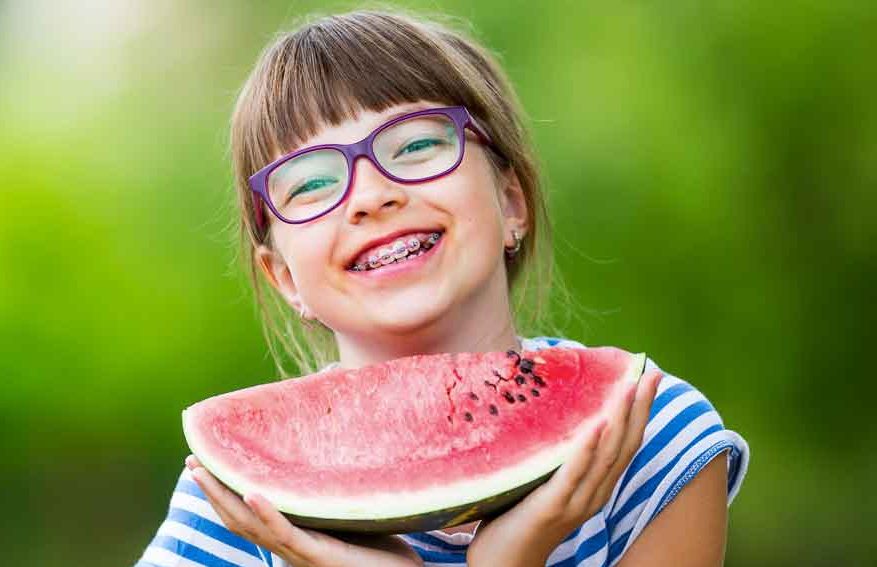Foods to Eat with Braces

From what foods to eat with braces and how to floss with braces, you need some information. Here are some answers to most common questions.
The best reason to get braces for your child is to prevent problems in the future. Crooked or crowded teeth, overbites or underbites, and problems with the jaw could lead to more tooth decay, gum disease, headaches, and earaches, or even biting or chewing problems.
“Getting braces doesn’t have to be a scary process, but it can be if you haven’t had some of the more common questions answered ahead of time,” explains Karson Kupiec, DDS, a second-generation orthodontist at Kupiec Orthodontics & Pediatric Dentistry, located in Rancho Santa Fe, Calif. “The last thing you want is to go into the treatment process without feeling comfortable. When parents feel comfortable and confident about it, so will the kids. They often mimic their feelings.”
YOU MIGHT ALSO LIKE: How to Keep Your Gums Healthy
Here are answers to some common questions, including what you can eat with braces.
When should I have my child evaluated?
Bring your child to an orthodontist by age seven, while she still has baby teeth and her mouth is developing (this applies to boys, too). Baby teeth set the pattern for adult teeth, and their location and how they fall out are clues to the future. Even if her teeth look straight, there may be problems underneath. By age seven, enough permanent teeth will have emerged for your orthodontist to detect the patterns.
Other issues might mean you should see an orthodontist earlier. Talk to your child’s dentist if your child has trouble chewing or biting, bites her cheek at the roof of her mouth, or has visible problems in her teeth or jaw.
Especially, if your child has visible gaps, you might start with braces as early as the age of 10. Usually, she’ll have to wear braces for a year or two, followed by a retainer.
Will my child be teased?
You might worry that other kids will tease your child if she wears braces. Actually, noticeable problems with teeth like gaps also can become a target for bullying, according to a study that collected tweets about teeth. One example: “Front teeth gaps aren’t fun bc throughout my whole childhood I was bullied about it to the point where I stopped smiling & talking.”
Does getting braces hurt?
Getting braces can cause sores in the mouth, so for the first few days your child will be more comfortable with soft food like soup, pasta, and bananas. The interconnecting wires are tightened at each visit, which causes a mild pressure on the brackets or bands. Any soreness goes away quickly. Your child’s dentist may need to pull teeth as well.
How much do braces cost?
The range runs from $3,000 to $13,000 for metal braces, and up to $3,000 more for ceramics. Some orthodontists offer payment plans. Many health insurance plans partially cover braces for children, and you may be able to buy supplemental orthodontic insurance. Ask about the percentage covered and the lifetime maximum. Stick to the same insurance while your child is being treated.
What not to eat with braces?
Your child should stay away from the usual evils: sugary and starchy foods that that lead to tooth decay and gum disease. In particular, the foods to avoid with braces are sticky, chewy sweets like caramels that can damage the wires and loosen the brackets.
Hard, crunchy snacks — popcorn, nuts, and hard candy — can break the wires. Warn your child against chewing ice cubes, biting her lip, and pushing her tongue against her teeth.
Foods to eat with braces
Here’s a healthy list of foods to eat with braces:
- Dairy, including pudding and soft cheeses
- Breads, such as lunch bread, soft tortillas, pancakes, and even muffins
- Grains, such as noodles, pastas, and rice
- Meats, such as chicken, meatballs, lunch meats
- Seafood, particularly tuna, salmon, and crab
- Vegetables: mashed potatoes, peas, yams, spinach, beans
- Fruits: apple sauce and bananas
- Eggs, hot dogs, hamburgers, chili
How do you brush your teeth with braces? How to floss with braces?
Your orthodontist should walk your child through the process. Your child will remove anything loose in the braces and then brush each wire in her mouth, moving from top to bottom.
She will need to brush her teeth, and floss, just like anyone else, ideally after each meal. She should use waxed floss and thread it carefully under the main wire before passing between any two teeth, then move it up and down gently. She might find it easier to use a Waterpik to flush out any bits of food that get caught between the braces and her teeth.
Updated:
October 14, 2022
Reviewed By:
Janet O’Dell, RN